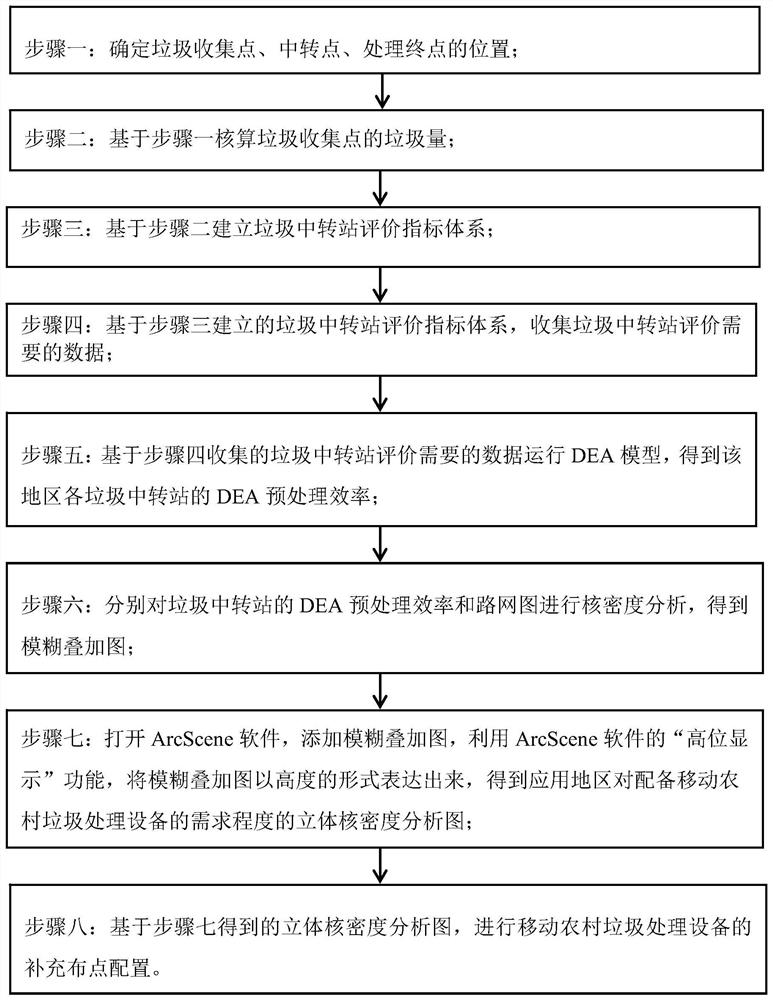Mobile rural garbage treatment equipment distribution method based on DEA and nuclear density
A technology of garbage disposal equipment and nuclear density, applied in the fields of garbage transmission, garbage collection, data processing applications, etc., can solve the problems of low garbage collection efficiency and processing efficiency, achieve scientific management decision-making, reduce total cost, and data superposition results clear effect
- Summary
- Abstract
- Description
- Claims
- Application Information
AI Technical Summary
Problems solved by technology
Method used
Image
Examples
specific Embodiment approach 1
[0023] Specific implementation mode 1: The specific process of the mobile rural garbage disposal equipment distribution method based on DEA and kernel density in this implementation mode is as follows:
[0024] Step 1: Determine the locations of garbage collection points, transfer points, and processing destinations;
[0025] Step 2: Calculate the amount of garbage at the garbage collection point based on Step 1;
[0026] Step 3: Establish an evaluation index system for waste transfer stations based on Step 2;
[0027] Step 4: Based on the waste transfer station evaluation index system established in step 3, collect the data needed for waste transfer station evaluation;
[0028] Step 5: Run the DEA model based on the data collected in step 4 for the evaluation of garbage transfer stations to obtain the DEA pretreatment efficiency of each garbage transfer station in the area;
[0029] The DEA model is a data envelopment analysis model (Data Envelopment Analysis, DEA);
[003...
specific Embodiment approach 2
[0035] Specific embodiment 2: The difference between this embodiment and specific embodiment 1 is that in the step 1, the positions of garbage collection points, transfer points, and processing terminals are determined; the specific process is:
[0036] The positioning method of the garbage transfer point and the garbage disposal terminal is as follows: the location data of the garbage transfer point and the garbage disposal terminal of a certain city or rural area are obtained through field research or network inquiry, and are placed on the administrative division map or topographic map loaded by ArcGIS software. The location data of the garbage transfer point and the garbage treatment terminal are marked one by one;
[0037] There are many ways to locate garbage collection points, and the selection of the way is mainly determined by the accessibility of data.
[0038] The positioning method of the garbage collection point is: if the trash can in the application area has the ...
specific Embodiment approach 3
[0042] Specific embodiment three: the difference between this embodiment and specific embodiment one or two is that in the step two, the amount of garbage at the garbage collection point is calculated based on step one; the specific process is:
[0043] Before accounting, it is necessary to clarify the types of garbage to be collected and transported.
[0044] For areas that have implemented waste classification policies, through field investigations, determine the classification and treatment methods of various types of waste and the production of domestic waste in various places;
[0045]For areas that have not implemented garbage classification policies, refer to the "Technical Regulations for Domestic Waste Collection and Transportation" to calculate and predict the local domestic waste production.
[0046] Other steps and parameters are the same as those in Embodiment 1 or Embodiment 2.
PUM
 Login to View More
Login to View More Abstract
Description
Claims
Application Information
 Login to View More
Login to View More - R&D
- Intellectual Property
- Life Sciences
- Materials
- Tech Scout
- Unparalleled Data Quality
- Higher Quality Content
- 60% Fewer Hallucinations
Browse by: Latest US Patents, China's latest patents, Technical Efficacy Thesaurus, Application Domain, Technology Topic, Popular Technical Reports.
© 2025 PatSnap. All rights reserved.Legal|Privacy policy|Modern Slavery Act Transparency Statement|Sitemap|About US| Contact US: help@patsnap.com

